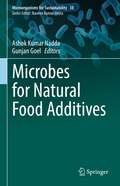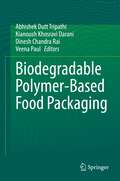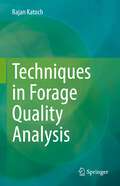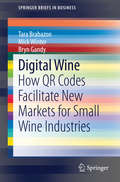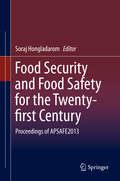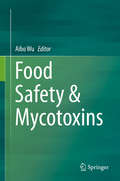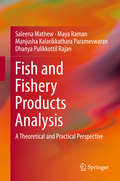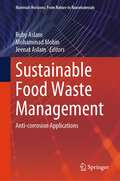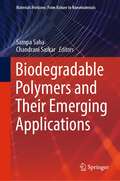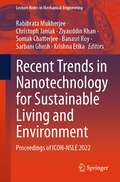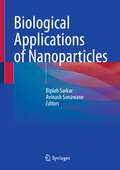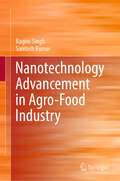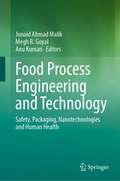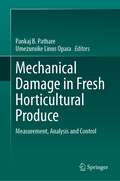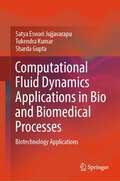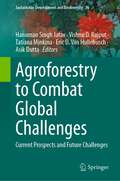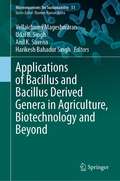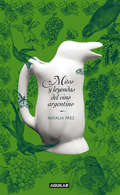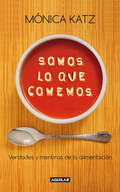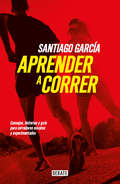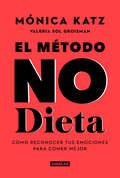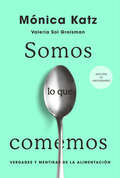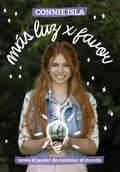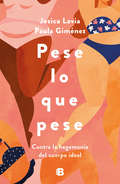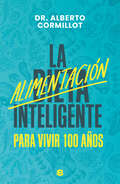- Table View
- List View
Microbes for Natural Food Additives (Microorganisms for Sustainability #38)
by Ashok Kumar Nadda Gunjan GoelThis book provides all the aspects of microbes for food additives, and a detailed description of their different categories. The chapters provide a step-by-step overview of microbial food additives as enzymes, antioxidants, stabilizers, emulsifiers, organic acids, colorants, sweeteners, flavoring compounds that have been used commercially by industrialists. In addition, an emphasis on the use of microbes as therapeutic agents such as probiotics and enzymes have also been given in the respective chapters. Furthermore, the book also comprises the detailed description of legislation and policies for the use of microbial additives at large scale in different food industries. Therefore, this book provides a comprehensive, state of art updated literature which can be used by the food scientists, nutritionists, microbiologists and a health-conscious layman to check the food additive list on a product for a nutritious and safer food.
Biodegradable Polymer-Based Food Packaging
by Abhishek Dutt Tripathi Kianoush Khosravi Darani Dinesh Chandra Rai Veena PaulThis book covers different aspects of biodegradable packaging, such as their sourcing and application in food industries. The book focuses on the production and characterization of biodegradable food packaging derived from plant, animal and microbial sources. Chapters highlight the nano-technological interventions in biodegradable food packaging and the less studied microbial biopolymer-based biodegradable food packaging makes it distinct from other related books. It includes the latest research and development in the areas of food processing, food packaging, material science and polymeric science. It also discusses the standards and regulatory guidelines about the biodegradability testing of these polymers.This book is meant for researchers in food science, food packaging, bioprocess technology, polymer science and biochemical engineering. It is also beneficial for faculty members and students of food microbiology, food technology, dairy technology. The book is also meant for small entrepreneurs and farmers who are interested in bio-plastic usage for food packaging.
Techniques in Forage Quality Analysis
by Rajan KatochThe book covers different techniques and methodologies involved in the nutritional quality analysis of forages. It also discusses the nutritional quality, anti-nutritional components, factors affecting forage quality, feed processing and conservation. Different techniques and methodologies have been presented in a simplified manner. The book has been divided in separate chapters and each chapter discusses different aspect of forage quality. Further, the book also covers the topics on conservation and processing of forages and management techniques for improving the forage nutritional quality. This book is an essential source of information for research scholars, post-graduate students and scientists working on forage quality estimation and also in livestock and dairy industries.
Digital Wine
by Tara Brabazon Mick Winter Bryn GandyThis book explores the way in which QR codes (Quick Response codes) can help the wine industry facilitate distribution and more effectively market and sell their product. It examines the interventions, invention and opportunities brought about by QR codes for the wine industry. It also investigates how QR codes can help enable regional development as well as information and knowledge about winemakers and regions. The book begins with an introduction to QR codes. It explains how to use them as well as shows how QR codes combine analogue and online promotion and information dissemination. Next, the book explores strategies and examples from the creative industries, small nation theory and emerging wine industries. It then goes on to examine how to integrate QR codes with wine media, including marketing the bottle and using QR codes to build new wine regions. The book concludes with a case study of how Aotearoa/New Zealand wine producers deploy QR codes. QR codes can store and digitally present, a range of helpful data, including URL links, geo-coordinates and text and can be scanned by smart phones, making them a useful marketing and business tool. Presenting detail research on how QR codes can enhance the relationship between producers and consumers as well as aid regional development in the wine industry, this book will be of interest to academics focusing on Wine Studies, small and medium sized enterprises (SMEs) and practitioners and researchers from the creative industries sector. In addition, while this book focuses on the wine industry, the information that it presents about QR codes is relevant and applicable for an array of industries that require a tether between analogue and digital, physical and virtual, especially food and primary production.
Food Security and Food Safety for the Twenty-first Century
by Soraj HongladaromThis book is a collection of selected papers that were presented at the First International Conference of the Asia-Pacific Society for Agricultural and Food Ethics (APSAFE 2013), which was held at Chulalongkorn University from November 28 - 30, 2013. The papers are interdisciplinary, containing insights into food security and food ethics from a variety of perspectives, including, but not limited to, philosophy, sociology, law, sociology, economics, as well as the natural sciences. The theme of the conference was to consider the interplay and balance between food security and food ethics as the world approaches the middle part of the twenty-first century.
Food Safety & Mycotoxins
by Aibo WuMycotoxins are increasingly attracting attention at thegovernmental, public and academic level worldwide, due to more frequent and serious contaminations of food and feedstuffs, which pose a serious threat to human health and animal production. This book reviews the latest research on mycotoxins that directly concern food safety, and especially focuses on detection technologies, risk assessment and control strategiescurrently being used in China. Gathering contributions from over 20 respected researchers, the book will benefit graduatestudents, researchers and management groups from various disciplines, including food science and technology, analytical chemistry, plant pathology, public health, etc.
Fish and Fishery Products Analysis: A Theoretical and Practical Perspective
by Saleena Mathew Maya Raman Manjusha Kalarikkathara Parameswaran Dhanya Pulikkottil RajanThis novel and informative book discusses the various aspects of seafood quality. The book is divided into 7 broad sections, each tackling a different aspect. The first section covers the general aspects relevant to the nutritional quality of the fish and the various extraction protocols for macro-/ micro-nutrients. The second section provides insights into handling and the principles of thermal and non-thermal processing techniques for commercially important fishery products. The quality standards and safety concerns in the seafood industry and consumption are discussed in this section. The freshness indices of the processed products including biochemical, microbiological and toxicological characteristics are also included. The third section discusses the physico-chemical characteristics and quality parameters of potable water/ ice. The fourth section includes the quality assessment of various toxicants related to seafood products. The fifth section deals with the specific aspects such as principle, instrument and procedures of conventional and novel analytical instruments relevant to the seafood industry. The sixth section deals with the seafood waste management including solid and liquid seafood wastes. Presently, there is a great awareness regarding environmental sustainable processing/ preservation techniques. The final chapter discusses the bioactive compounds from under-utilized marine sources showing pharmaceutical/ nutraceutical applications.
Sustainable Food Waste Management: Anti-corrosion Applications (Materials Horizons: From Nature to Nanomaterials)
by Ruby Aslam Mohammad Mobin Jeenat AslamThis book highlights established research and technology on corrosion inhibitors and bio-waste management. It further discusses emerging aspects of utilizing food waste in the field of corrosion inhibition. The topics covered include overview on bio-waste and their management, different types of food waste (i.e., agricultural, vegetable and fruit/fruit juice, plant waste, slaughterhouse trash), and their application as corrosion inhibitors and mitigation of corrosion. It also discusses economic aspects and commercialization of food waste as corrosion inhibitors. The book is a valuable reference for beginners, researchers, and professionals working in the areas of sustainability, food waste management, and material science.
Biodegradable Polymers and Their Emerging Applications (Materials Horizons: From Nature to Nanomaterials)
by Sampa Saha Chandrani SarkarBio-degradable polymers are rapidly emerging as a sustainable alternative to traditional petroleum-based plastics and polymers. However, the synthesis and processing of such polymers present unique challenges and opportunities. In this comprehensive volume, Dr. Saha and her team provide an in-depth exploration of the synthesis and processing of bio-degradable polymers and their emerging applications in various sectors from drug delivery to food packaging. Covering a wide range of topics, including synthesis, modification, processing techniques, and few of their advanced applications in emerging areas, this book provides a comprehensive overview of the field. The authors also delve into cutting-edge research on the synthesis, properties and applications of bio-degradable polymers in various fields, such as agricultural, food preservation, biomedical arena, energy storage and other advanced application areas. This volume is an essential resource for scientists, engineers, and policymakers interested in the future of sustainable materials. Whether you are a researcher looking to expand your knowledge of biodegradable polymer synthesis and processing or a policymaker interested in the potential of biodegradable polymers to reduce our reliance on fossil fuels, this book is an invaluable guide to the field.
Recent Trends in Nanotechnology for Sustainable Living and Environment: Proceedings of ICON-NSLE 2022 (Lecture Notes in Mechanical Engineering)
by Rabibrata Mukherjee Christoph Janiak Ziyauddin Khan Somak Chatterjee Banasri Roy Sarbani Ghosh Krishna EtikaThis book presents the select proceedings of International Conference on Nanotechnology for Sustainable Living and Environment (ICON-NSLE 2022). It covers the latest trends in nanotechnology and its applications in various sectors such as energy, environment, food technology, and biomedicine. Various topics covered in this book are nanomaterial preparation and characterization, nanobiotechnology, nanodevices, waste to wealth, pollution abatement, renewable energy, advanced materials, sensors and portable electronics, biomedical applications, food preservation, etc. This book is useful for researchers and professionals working in the area of nanotechnology and environment sustainability.
Biological Applications of Nanoparticles
by Biplab Sarkar Avinash SonawaneThis textbook for graduate and postgraduate students provides comprehensive applications of nanoparticles in medicine, agriculture, and environmental sciences. The initial chapter covers basic topics related to types, synthesis, structure, and properties of various nanoparticles. It further discusses the wide range of applications of nanoparticles in medicine, agriculture, and the environment. The book presents nano-electronic biosensors that are used to diagnose and monitor the progression of human diseases. It summarizes the opportunities and challenges of nanotechnology in the agriculture and food sector highlighting the scientific, technical, regulatory, safety, and societal impacts. Additionally, it illustrates the applications of nanotechnology in the field of aquaculture medicine, bioinformatics and food technology. The textbook examines the development and administration of nano-medicines , their applications, advantages, and limitations for the treatment and prophylaxis of a broad range of diseases. Lastly, the textbook explores the recent advances in the field of nanobusiness and nanotechnology issues in intellectual property management( IPR).
Nanotechnology Advancement in Agro-Food Industry
by Ragini Singh Santosh KumarThis book provides a comprehensive insight into the growth of nanotechnology in the agri-food industry. Currently, nanotechnology serves as the most promising means to resolve the issues encountered in the food sector, as it enables the production of high-quality food with exceptional characteristics such as extended shelf life, flavor, freshness, and high nutritional content. This book focuses on the applications of nanotechnology in various fields such as smart packaging, processing, and preservation of food. It also emphasizes the role of nanomaterials in strategic design of nutraceuticals and functional foods. Along with providing an overview of the innovations and application, this book also describes future perspectives, and offers insights to ensure consumer confidence in terms of safe use. In this context the application of nanomaterials as nanosensors is additional covered. The book provides readers with a deep knowledge regarding nanomaterials-based biosensors (colorimetric, electrochemical, fiber-based) for detection of pathogens in contaminated food. Factors affecting risk assessment regulations and safety concerns regarding the use of nanomaterials in food industry have also been discussed in detail. Given its scope, this book appeals to a wider readership, especially for researchers and students who work in food agronomy and nanomaterials and nanotechnology related fields.
Food Process Engineering and Technology: Safety, Packaging, Nanotechnologies and Human Health
by Junaid Ahmad Malik Megh R. Goyal Anu KumariThis book focuses on novel technologies related to food processing technology and engineering. It also focuses on food safety, quality and management, the scope of the Internet of Things (IoT) in food processing and its management, bioengineering tools for crop improvement in agriculture, recent innovations in food packaging, nanotechnology in food processing, and the nutritional health benefits of food. 3D printed food, an interesting and increasingly popular concept among the public today, is a meal prepared through an automated additive process using 3D food printers. This book is a ready reference for food researchers, students, and industry professionals. The book updates the current scenario of food processing technology and engineering for readers from agriculture and its allied fields including students and researchers of food science and technology, dairy science and technology, packaging industry, people working in food safety organisations, and researchers in the field of nanotechnology.
Mechanical Damage in Fresh Horticultural Produce: Measurement, Analysis and Control
by Pankaj B. Pathare Umezuruike Linus OparaThis book includes the impact, compression, vibration studies, and destructive and nondestructive techniques for bruise measurement. It is essential to detect bruises in the early stages of their formation and conduct a quantitative analysis of the degree of bruising, to ensure the accurate grading of bruised fruits and vegetables and reduce unnecessary economic losses. Bruise damage occurring between the point of harvest and consumption contributes the most to the decrease in fruit quality, reducing the market value and ultimately leading to significant reductions in potential revenue. SDG 12.3 aims to “by 2030, halve per capita global food waste at the retail and consumer levels and reduce food losses along production and supply chains, including post-harvest losses.” This book presents recent technological developments in bruise measurement, detection, and analysis of fresh horticultural produce. Given the rising demand for rapid and accurate methods of quality measurement in the horticultural produce industry, this book covers destructive and nondestructive techniques for bruise measurement. Selected applications of different nondestructive methods for various fresh produce commodities are also included. This book will interest graduate and undergraduate students, researchers, academics and engineers working in different aspects of the mechanical damage affected by postharvest handling practices, professionals working in the governments, and other authorities related to fresh horticultural produce quality, regulations, and safety.
Computational Fluid Dynamics Applications in Bio and Biomedical Processes: Biotechnology Applications
by Satya Eswari Jujjavarapu Tukendra Kumar Sharda GuptaThis book covers emerging areas in novel design and their hydrodynamic properties relevant to bioreactors, environmental system, electrochemical systems, food processing and biomedical engineering. This book uses an interdisciplinary approach to provide a comprehensive prospective simulation modeling and hydrodynamic study in advanced biotechnological process and includes reviews of the most recent state of art in modeling and simulation of flows in biological process, such as CFD. Written by internationally recognized researchers in the field, each chapter provides a strong introductory section that is useful to both readers currently in the field and readers interested in learning more about these areas.
Agroforestry to Combat Global Challenges: Current Prospects and Future Challenges (Sustainable Development and Biodiversity #36)
by Hanuman Singh Jatav Vishnu D. Rajput Tatiana Minkina Eric D. Van Hullebusch Asik DuttaThis edited book brings out comprehensive insights on agro-forestry systems to cope up climate change globally. The main essence of this book is to unfurl the positive sides of agri-silvipastoral system to reduce greenhouse gases (GHGs) and temperature. Agro-forestry can be defined as the farming practice combining field crops, perennial trees and livestock. The impact of agro-forestry on ecology is implacable which is thoroughly discussed under different heads in this book. In addition, the book is bundle of different novel sections including tables, graphical representation, and figures showcasing the bright side of agro-forestry system. Furthermore, trees which are important component of boosting socio-economic conditions, especially for the indigenous populations have also been discussed meticulously. Hence, all together this book deciphers an account of agro-forestry practices in society and environment along with the major pros- and cons- of the system. Undoubtedly, this information could enrich the scholarly knowledge for graduate research fellows, teachers, scientists, researchers, and environmentalists in gaining multifaceted information of agro-forestry system in both ecological and economical aspects. Different research highlights will be helpful for the policy makers to implement this novel practice in intensive production systems and harness the maximum benefits out of this.
Applications of Bacillus and Bacillus Derived Genera in Agriculture, Biotechnology and Beyond (Microorganisms for Sustainability #51)
by Vellaichamy Mageshwaran Udai B. Singh Anil K. Saxena Harikesh Bahadur SinghThis edited volume provides a comprehensive view of the recent developments on Bacillus and their application in agriculture and allied sectors in a global scenario. Research articles sharing a consolidated state-of-the-art development in this area are solicited for this book. This book is a complete package covering all spheres of diversity and taxonomy, nutrient supplementation, biotic and abiotic stress management, biofilm and endophytic colonization, commercialization and regulatory mechanisms, etc. Descriptions of cutting-edge techniques and novel approaches on Bacillus research is also covered. A part of the book concentrates on the biotic and abiotic stress management in several important crops. It contains 11 contributory chapters from eminent experts in the field of life sciences specially microbiology, plant pathology and biotechnology working on different aspects of Bacilli and their application in agriculture and allied sectors. This book is useful for Graduate, Post-graduate students, research scholars, and post doctorate scholars of plant science, plant microbiology, soil microbiology and plant pathology discipline researchers, academicians, industrialists, policy makers.
Mitos y leyendas del vino argentino
by Natalia PáezFruto de una investigación minuciosa, los relatos reunidos en Mitos y leyendas del vino argentino conforman una historia no oficial de nuestra bebida nacional. Un jinete fantasma recorre las fincas donde se plantaron las primeras cepas de Malbec; un oscuro bodeguero con fama de vampiro aterra a sus vecinos; una bodega está habitada por espectros que hacen oír sus voces. Seres fantásticos, míticos, tan argentinos como la jarra en forma de pingüino, curanderas de tormentas, trovadores del vino, conviven en este libro con San Martín, Sarmiento y Eva Perón. Realidad y leyenda se mezclan en las narraciones de los descendientes de aquellos inmigrantes emprendedores que fundaron una de las actividades económicas más prósperas del país, entre ellos, el mejor enólogo argentino del siglo XX. Además de esas narraciones, Natalia Páez nos habla del vino en la poesía, en el tango y en el fútbol. Y describe con lujo de detalles las dos fiestas de la vendimia que se celebran todos los años en Mendoza.
Somos lo que comemos: Verdades y mentiras de la alimientación
by Mónica KatzMónica Katz nos introduce en el apasionante mundo de la alimentación. ¿Qué es lo que en verdad consumimos cada vez que comemos? Comer es imprescindible para vivir, pero también comemos para obtener placer, por aburrimiento, para calmarnos, para no pensar, para reunirnos con amigos y familia, para celebrar, para seducir. Y vivimos rodeados de estímulos que incitan a comer: programas de TV, publicidades, restaurantes, bares, kioscos y comercios con góndolas rebosantes de alimentos y bebidas, al alcance de nuestra mano. En ese sentido, la industria ha logrado producir alimentos a gran escala, procesados y especialmente diseñados para el consumo, a tal punto que no siempre sabemos qué es lo que en verdad consumimos cada vez que comemos. Mónica Katz nos introduce en el apasionante mundo de la alimentación y descompone en todas sus facetas el prisma de esa actividad humana. ¿Por qué nos gustan tanto ciertas comidas y por qué rechazamos otras? ¿Qué función cumplen los sentidos en la selección y el consumo? ¿Cómo utiliza la industria esos conocimientos? ¿Qué responsabilidad tiene el Estado en el control y la producción de alimentos? ¿Cuáles son beneficiosos para nuestro organismo, cuánto debemos consumir y cómo tenemos que hacerlo para lograr, sin recurrir a ninguna dieta, disfrutar de la comida y ganar en salud?
Aprender a correr: Consejos, historias y guía para corredores novatos y experimentados
by Santiago GarcíaAprender a correr es el libro más completo sobre el running escrito en Argentina. Es un manual para principiantes, pero también para corredores experimentados. Combina esos tips básicos que muchos no conocen u olvidan con consejos de expertos de todas las áreas. Como muchos corredores del mundo, Santiago García descubrió la pasión por el running a una edad a la que los atletas profesionales se retiran pero los amateurs comienzan. Y como para tantos otros, esta disciplina significó una segunda oportunidad en su vida, a la que le dedicó desde entonces toda su energía y conocimiento. De eso trata este libro: de entender que cualquiera puede correr, y que nunca es tarde para arrancar. Y de cómo hacerlo bien, con ganas, mirando siempre para adelante. Después de contar su experiencia en Correr para vivir, vivir para correr, García abre aquí el juego a otros corredores y otras historias. Todo lo que le importa al corredor está acá. Prevenir lesiones. Las diferentes formas de entrenamiento. La dieta y el descanso. La primera carrera. Correr para conocer la ciudad, el país, todo el planeta. Aprender a correr es el volumen más completo sobre el running escrito en Argentina. El mejor manual posible para principiantes, pero también para corredores experimentados. La combinación perfecta de los tips más básicos con los consejos de los especialistas, que comparten sus secretos para que hagamos del running la experiencia más importante y satisfactoria de nuestras vidas.
El método No Dieta: Cómo reconocer tus emociones para comer mejor
by Mónica Katz Valeria Sol GroismanEl manejo de las emociones y de otros obstáculos son fundamentales a la hora de emprender una dieta porque de eso depende que podamos encarar un cambio en nuestra forma de alimentarnos. A diez años de No Dieta. Puentes entre la alimentación y el placer, Mónica Katz junto con su hija Valeria Sol Groisman continúa profundizando su revolucionario trabajo sobre la alimentación, que indaga no solo en lo que comemos sino también en las razones para realizar una dieta. Esos mismos motivos pueden ser las causas para abandonar un régimen. Las estrategias para perder peso, casi todas restrictivas, fracasan porque se concentran en la comida. En este libro, las autoras ponen el foco en esos otros factores que hacen que una dieta no funcione: las emociones, los fanatismos, la información de los medios de comunicación y las redes sociales, y los mitos alimentarios. "Estoy cansada -dice Katz- de ver desfilar pacientes y conocidos que han invertido años, esfuerzo, batallas familiares y dinero en dietas de moda, y están más gordos que nunca. [...] Por más que reformulemos los alimentos, que regulemos su calidad, sus porciones, su publicidad, por más de que mejoremos el acceso a la actividad física y al juego como derecho de grandes y chicos, si no enseñamos que las emociones son necesarias (por eso mismo no deberíamos taparlas con comida), seguiremos sin hallar soluciones". El método No Dieta nos ofrece las herramientas para escuchar nuestras emociones, modificar nuestros hábitos y tener una alimentación saludable sin fracasar en el intento.
Somos lo que comemos: Verdades y mentiras de la alimentación
by Mónica KatzEn esta edición décimo aniversario, revisada y actualizada, Mónica Katz y Valeria Sol Groisman nos introducen en el apasionante mundo de la alimentación y descomponen en todas sus facetas el prisma de esa actividad humana. En esta edición aniversario, revisada y actualizada, Mónica Katz y Valeria Sol Groisman nos introducen en el apasionante mundo de la alimentación y describen todas las facetas de esta actividad humana. ¿Por qué nos gustan ciertas comidas y rechazamos otras? ¿Qué función cumplen los sentidos? ¿Cómo utiliza la industria esos conocimientos? ¿Qué responsabilidad tiene el Estado en el control y la producción de los alimentos? ¿Cuáles son beneficiosos para nuestro organismo, cuánto debemos consumir y cómo tenemos que hacerlo para lograr disfrutar de la comida, sin recurrir a ninguna dieta? ¿Alcanza la ley de etiquetado? Este libro es fundamental porque comer es imprescindible para vivir. Pero también porque lo hacemos para obtener placer, por aburrimiento, para calmarnos, para reunirnos con amigos y familia, para celebrar, para seducir. Y vivimos rodeados de estímulos que incitan a comer: programas de televisión, publicidades, restaurantes, bares, kioscos y comercios con góndolas rebosantes de alimentos y bebidas al alcance de nuestra mano. Como la industria ha logrado producir alimentos a gran escala, procesados y especialmente diseñados para el consumo, no siempre sabemos qué es lo que en verdad consumimos cada vez que comemos.
Más luz x favor: Tenés el poder de cambiar el mundo
by Connie IslaUna de las influencers veganas argentinas de mayor crecimiento cuenta su viaje profundamente personal, un recorrido que va desde su temprana pasión por distintas formas de expresión artística hasta su experiencia de autodescubrimiento y su entrega completa a la causa feminista y a la lucha por un estilo de vida sustentable. Hola. Soy Connie, y quiero agradecerte que tengas mi libro en tus manos. Vengo a proponerte que me acompañes en un viaje, un viaje personal y revelador. Un recorrido por algunas cosas que hice en mi vida, gracias a las cuales me caí, me levanté, reflexioné, aprendí, cambié y entendí que está en nuestras manos hacer de este un mundo mejor. Y que para eso primero es necesario estar dispuestos a conocer, a cuestionarnos y saber algunas cosas que a veces preferiríamos no saber: de dónde viene eso que comemos, quién hizo las prendas con las que nos vestimos, cuánto tarda en degradarse esa botella de plástico que usamos y desechamos, y por qué a veces miramos para otro lado cuando se nos presenta esa verdad incómoda. Espero que acá encuentres no sólo respuestas, sino también preguntas, así como también herramientas para ayudarte a transitar este camino largo pero poderoso. Porque la información es poder, y tenemos el poder de cambiar el mundo. Sí, vos, una sola persona, aunque te cueste creerlo. Cada pequeña acción cuenta. Necesitamos acercarnos un poco más. Tener más compasión. Más conciencia. Más empatía. Más amor. Más luz, por favor.
Pese lo que pese: Contra la hegemonía del cuerpo ideal
by Jesica Lavia Paula GiménezDesde una mirada feminista, Jesica Lavia, nutricionista, y Paula Giménez, periodista especializada en género, reflexionan sobre cómo el culto al "cuerpo ideal" y la obsesión por el peso despliegan dietas "milagrosas" e instalaron una "dictadura de la belleza" de la cual parece difícil escapar y cuyas víctimas principales y más visibles son las mujeres. «Queremos -dicen las autoras- que todas las feminidades podamos habitarnos un poco más amorosamente. Les hablamos a las gordas, las gorditas, las rellenitas, las flacas, las escuálidas, las petisas, las altas, las culonas, las caderonas, las tetonas y las chatas. A todas ellas y a nosotras mismas».
La alimentación inteligente: Para vivir 100 años
by Dr. Alberto CormillotEl nuevo libro del Dr. Cormillot reúne sus experiencias e investigaciones y propone un plan de acción viable para ayudarnos a vivir una vida larga y plena a través de hábitos de alimentación saludables, completos y equilibrados. En algunas regiones del planeta llamadas Zonas Azules los habitantes centenarios son moneda frecuente. ¿Podremos copiar algunos de sus secretos? ¿Cuántos años te gustaría vivir? ¿La convivencia realmente influye en que engordes? ¿Qué te dicen las palabras "comensalidad" y "gastroanomia" (no gastronomía)? ¿Disfrutar relajadamente en tu silla o sillón favorito tiene algún efecto en tu expectativa de vida? ¿Qué impacto causa sobre tu salud ser muy activo y dormir pocas horas por noche? ¿Cuál sería, para vos, un descenso de peso razonable en un programa para adelgazar? ¿Pesarse frecuentemente ayuda a adelgazar o lo dificulta? A la pregunta "Qué dieta hago", ¿qué puntaje de 0 (la peor) a 10 (la mejor) le pondrías? Nuestras abuelas decían que los malestares intestinales se originaban en problemas emocionales y viceversa. ¿Mito o realidad? Además de brindar todas estas respuestas, La dieta alimentación inteligente te propone el mejor plan del mundo, con ilustraciones para aprender a comer y elegir los alimentos más convenientes, innovar con recetas antioxidantes, antiinflamatorias ¡y light!, incorporar recursos para cambiar hábitos y sostener logros en el tiempo, todas claves para firmar la paz con el cuerpo y la comida. La información está aquí. El eje es el cambio. El protagonista sos vos.
